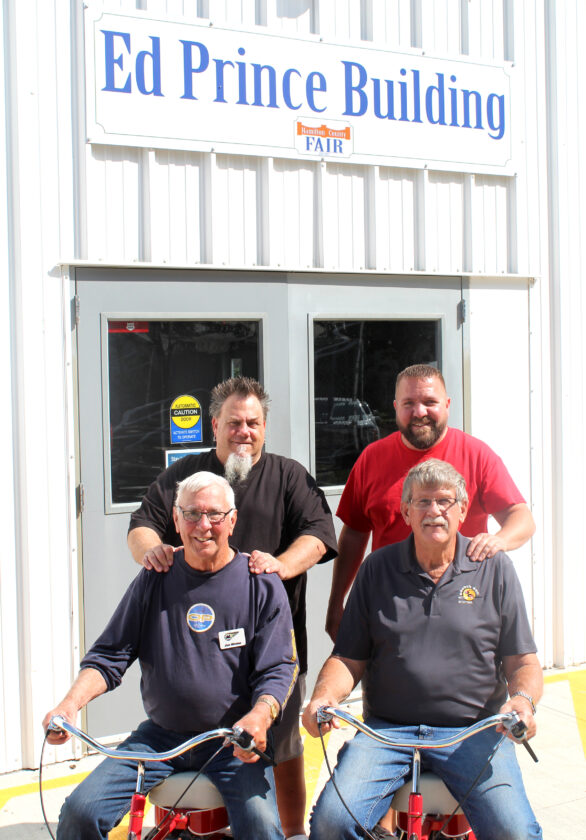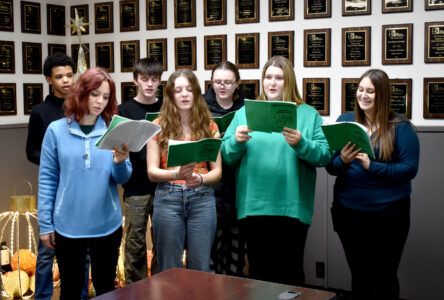It’s everywhere in Webster City — can you feel it? It’s: Doodle Bug Love

Ready for the start of this year's annual Doodle Bug Reunion are back row from left: Kevin Rosen, of Riverside, California; and Matt Smith, of Fremont, Nebraska. In the front row from left are Jim Winter, of Jackson, Michigan; and Gerald Huisman, of Webster City.
In 1946, life was returning to normal in Webster City. America and its allies had prevailed over the forces of tyranny on both the Atlantic and Pacific fronts. People could, once more, focus on their own future. They were building and buying homes, and filling them with children who would form the biggest population spike in American history up to that time: the baby boomers.
But, those years were also a time of persistent inflation, and among the biggest costs a family faced were related to the family automobile: tires, batteries, gasoline.
Cars themselves — and everything that kept them running — had been rationed during the war. High demand after the war kept everything expensive into the early 1950s.
The Doodle Bug: An American Classic
Harry Mertz, design engineer at Beam Industries in Webster City, looked at the company’s laundry appliance business and saw opportunity. By modifying the fluid-drive transmission used in washing machines, it would fit into a small motor scooter. The company’s purchasing agents, already buying thousands of electric motors a year, could also buy the 1.5 horsepower gasoline engine Mertz specified for the scooter. The factory’s existing tools, fixtures and employees making washer and dryer cabinets could also make the frame, housings and fenders for a scooter.
Why make a scooter in the first place?
Everywhere Mertz looked he saw people struggling to afford a car. Auto plants, converted to war material manufacturing early in the war, were slow to resume car production, so demand far out-paced supply in the early years after WW II ended. This kept prices for new cars inordinately high.
A well-designed, well-made, inexpensive scooter, though, could quickly be tooled and put into production. It could take the place of a second car in many families, or provide basic transportation to a teenager going to school, holding down an after-school job or delivering newspapers. Farm kids could go to town whenever they wanted without pestering their folks.
Yes, the company concluded, demand was there.
With a patent filed on April 15, 1946, the scooter went into production. The factory built them in runs of 10,000, to “make the numbers work.” The bikes were sold by Western Auto and Gambles stores, which were owned by Gamble Skogmo, Inc., which also owned Beam.
In the early 1950s, Gamble Skogmo, with headquarters in St. Louis Park, Minnesota, also owned Mode O Day clothing stores, Leath Furniture stores, Red Owl Grocery, Snyder Drug, and the Alden’s mail order catalog. Beam made washers and dryers, for sale through Western Auto and Gambles, under its Coronado brand. It was a true, vertically-integrated conglomerate years before such companies were common.
The 1946 suggested retail price of the scooters, sold under the brand name “Hiawatha” and the far more marketable “Doodle Bug” was $89.98. By comparison, a 1946 Chevrolet Fleetmaster Coupe sold for just over $1,000. For those looking for a safer ride after dark, a set of head and tail lights was available as an extra-cost option.
There are those who claim the Doodle Bug name is a tribute to U.S. Army General James “Jimmie” Doolittle, who is best known for leading a retaliatory air strike against the main Japanese islands after the Pearl Harbor attacks that preceded WW II. He had advocated use of small scooters by army personnel and it’s possible a bike designed for the Army, under his direction, was the inspiration for Beam’s scooter.
As the years went on, production costs increased, and so did prices — rising to $149.95 in 1947 and $169.95 in 1948.
The rapidly rising costs may have out-paced the ability of consumers to buy them. Production ended in 1948 with just 40,000 having been made.
Those very small numbers make Doodle Bugs both valuable and collectible.
The Doodle Bug Club and Webster City reunions
Bill and Marcene Moore, of Mason City, realized Doodle Bug Love was real, and there were legions of fans across the country who shared their interest. Along with Vern Ratcliff, of Webster City, they formed the Doodle Bug Club of America in the 1980s.
In 1987, they organized the first Doodle Bug Reunion in Webster City.
Marcene Moore remembered, “That first reunion was held in the country school at Wilson Brewer Park. About 10 people attended and there were five, maybe six scooters. But we were launched.”
“Bill started writing the club’s newsletter and ended up doing it for 35 years,” she said. “The newsletter kept the club together between reunions and spread the word.”
Do you wonder what causes people to interrupt busy lives and drive to Webster City every September for another Doodle Bug Reunion? Well, it’s Doodle Bug Love, but also love for those who’ve become a “reunion family” that’s formed over the years.
We talked to three of them for this article.
Matt Smith, of Fremont, Nebraska, came to his first reunion in 1992.
“I’ve been coming ever since and only missed a few. It’s my favorite week of the year. I love Webster City. It’s clean, people are friendly, the food is good. I’ve never had any trouble here.”
Smith is the Doodle Bug Club of America’s unofficial technician. He helps other scooter owners troubleshoot problems with restoration and maintenance. He’s a walking compendium of Doodle Bug history and mechanical know-how. He and his wife took over the club newsletter.
Jim Winter, of Jackson, Michigan, has come to reunions for 15 years. He also doesn’t miss the Vintage Motorbike Club’s annual gathering in Portland, Indiana. It was there he was bluntly told: “If you don’t own a Doodle Bug, you’re nobody.”
Apparently, he took the advice to heart, paying $2,000 for one in 2010. Such prices aren’t uncommon, and a few scooters change hands each year at the Webster City reunion. Many of the beautifully-restored bikes are intentionally sold to remain in the “family” of reunion attendees.
Winter said, “It’s nothing to drive 570 miles to Webster City to see my friends.”
His job at the annual get-together is security. With bikes and parts worth thousands of dollars, it’s a big responsibility. He camps just outside the entrance to the Ed Prince Building, where many events take place so he can be there when the building opens and there when it closes.
He echoed Smith’s comments about Webster City, adding, “We always have a nice banquet at the end.”
Kevin Rosen might get the prize for traveling the longest distance to the reunion. He lives in Riverside, California. It takes his family three long days of driving to get here.
“That first year, I wondered why I was going to Iowa, but the draw is the wonderful people — almost like family — you see here. One trip and I was hooked. I won’t miss this.”
Three generations of Rosens have been regulars at the Doodle Bug Reunion: Kevin’s father, Bryan; Kevin, and teenage daughter, Regan.
Kevin Rosen is clear in what keeps them coming back for more: “It’s Webster City. The town appreciates us. We get a police escort to safely ride our scooters around town; the town folk smile and welcome you. We don’t have that in Southern California.”
Reunion stories are legion.
Marcene Moore remembers: “One member put a bike in his plane, flew to Webster City airport, and drove his scooter into town.”
Gerald Huisman, president of today’s Doodle Bug Club of America, knew “a guy who came to a reunion with just a frame. He bought parts from almost everybody at the show. At the banquet at the end of the reunion, he had a working Doodle Bug he could ride.”
Like the Bug, this is a story of many parts.
A factory that needed a new product to sell.
A little scooter with an almost unbelievably loyal following.
And the small town in Iowa where it all happened.
Long after the Beam Industries production lines fell silent, though, it continues to happen every September in Webster City. It’s about the scooter, sure. But it’s more than that. It’s Doodle Bug Love.

